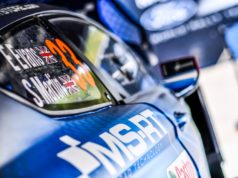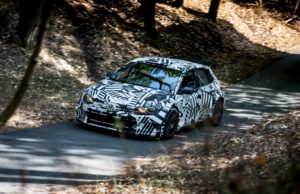Citroën Racing presented its 2017 WRC challenger – the new Citroën C3 WRC.
Since they first appeared in 1997, World Rally Cars regularly underwent changes to their definition, whether in order to manage performance or control costs. The most significant changes were from before the 2011 season, with more compact models with 1.6-litre direct injection turbo engines. The 2017 season sees the introduction of a new generation of cars – the fastest and most spectacular ever seen on the stages of the World Championship!
In all areas, the Citroën C3 WRC pushed back the boundaries of what has been done in the past. The weight-to-power ratio of the Citroën Racing engineers’ latest creation is 3.1kg/bhp, compared with 3.8 for its predecessor. The dramatic technological changes are clearly visible – in the wider wings, the substantial aerodynamic features and the four-wheel drive that now comes with a centrally-controlled differential.
Evaluation of the new regulations and the structural design of the New Citroën C3 began in April 2015
On 19 November 2015, when Citroën announced its sporting future, the C3 WRC already existed… virtually speaking, at least, on the CAD workstations.
On 11 April 2016 Kris Meeke drove the car on its first outing at the Versailles-Satory track. Shortly afterwards, the team set off for the south of France. There were tests there – on the gravel roads around Château Lastours. The car was with a special “camouflage” livery, designed to hide the styling features of the New Citroën C3. Development work continued on a variety of surfaces. Tests went on for around four to five days of testing each month. The team looked for both reliability and performance. At the end of June, the team delivered a second car, which was especially for tarmac testing.
The bodywork shape was final after several wind tunnel sessions. Kris Meeke conducted the majority of the testing. Craig Breen and Stéphane Lefebvre took over driving duties from the Northern Irishman on the final day of the tests.
Altogether, the Citroën C3 WRC completed ten test sessions and a total of 9,500 kilometres
The homologation by the FIA was on 13 December 2016.
Citroën Racing developed and built its own engines since 2010, in line with the FIA Global Racing Engine (GRE) regulations. The architecture, based on a four-cylinder 1.6-litre direct injection turbo engine, allows manufacturers to use their technology across several championships. Citroën used its experience in the WRC to design the engine of the Citroën C-Elysée WTCC. The information and knowledge acquired whilst spending three seasons competing on the world’s racetracks were used for the design of the Citroën C3 WRC engine.
The Citroën Racing engine is from a machined, aluminium cylinder block. This piece of metalwork must meet strict rules as regards minimum weight and the height of its centre of gravity. The surge in performance expected in 2017 can be explained by one main factor: the wider turbo restrictor, which increased from 33mm to 36mm.
The power was boosted by around 20% to 380bhp
The turbo pressure limit of 2.5 bars means that the torque remains relatively stable at about 400Nm. A 36 mm restrictor was already in use on the WTCC engine. That’s why the Citroën Racing engine specialists were able to get to grips quickly and confidently with the increased output and internal load.
In-depth work on reducing friction helped to improve the engine’s output and efficiency. Reliability was a key concern for the engineers. With a quota of three engines per car for the season, the specifications requirements are similar to those of the WTCC, where the powertrain has to last fewer kilometres, but at a higher speed.
The structural design of the Citroën C3 WRC is similar to that of its predecessors
The production body shell accommodates the composite fibre rear spoiler, the roll cage, the transmission tunnel and the subframe supporting the chassis and suspension systems. The C3 WRC is Citroën’s first World Rally Car, which has for a base a five-door bodywork.
The most visible of the changes is the increase in maximum width, which has risen to 1,875mm (+55mm), providing more stable handling and new aerodynamic options
A key component is the suspension and this area underwent some substantial changes. The spring-shock absorbers are now titled to increase travel. The suspension geometry will be different between the car’s tarmac and gravel versions.
The four-wheel drive has also undergone a major change. The centrally-controlled hydraulic differential is back. This system was used on the Xsara and C4 WRC. It allows the front and rear axles to rotate at different speeds. By controlling the hydraulic pressure in the central clutch, it is therefore possible to transfer torque from one axle to the other in order to offset understeer and reduce any slippage.
The Citroën C3 WRC’s muscular design and unique morphology are immediately striking
Like the production C3, the WRC bristles with freshness end energy. The aerodynamic changes contribute to the performance of the car. The downforce help to increase the stability of the car at high speeds. The air vents provide cooling for the engine, the transmission and the brakes. Before settling on the final bodywork design, the team tested several iterations. The high-standing front end is strong and compelling. It gives a powerful impression of robustness with a horizontally balanced outline right through from the waist.
The bumper is the centrepiece of the car’s aerodynamic performance. It incorporates a splitter and winglets, which generate downforce and reduce understeer. The lower part is different on the tarmac and gravel versions. The air intakes supply cool air to the radiator, the turbo intercooler and the brakes. Hot air is expelled by the air scoops on the bonnet and at the bottom of the front wings. Looking at the side, the first detail you notice is the floating roof held by the black windscreen pillars.
Citroën C3 WRC’s protective function shows through clearly in the balanced proportion between body panels and glazed surfaces
Lower down, the vehicle stands out thanks to the wide body sills that channel the lateral flow of air. The air vents (located on the rear doors) cool the brakes. The rear bumper boosts the expulsion of gravel and snow on loose surfaces. These aerodynamic forms echo in the 3D rear lamps, which lend a unique, high-tech identity to the Citroën C3.
Crowned by the centrally-positioned exhaust pipe, the rear diffuser provides yet further downforce by expelling the flow of air that passes underneath the car. Lastly, a spectacular rear spoiler completes the aerodynamic system. It consists of a lower “shovel” and a more complex upper level. For increased efficiency, the spoiler assembly is set back as well as raised by 50 mm compared with the previous regulations.

































